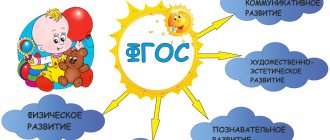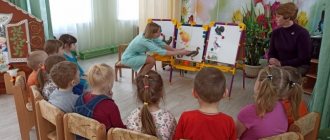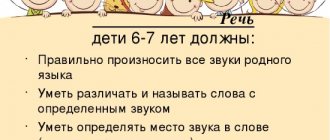Stuttering is not a disease, but a manifestation of the disease, one of its symptoms. Accordingly, in order to talk about treatment tactics for stuttering, it is necessary to establish exactly what disorder it is a manifestation of...
A large number of methods have been developed to get rid of stuttering. It is difficult to say which technique is suitable in each specific case. Today we bring to your attention the technique described in V.M. Lykov’s book “Stuttering in Preschool Children” (M., 1978).
The essence of stuttering
Stuttering is a fairly common phenomenon. However, everyday observations show that adults do not have a clear idea of stuttering, a clear understanding of the psychology of people who stutter, or knowledge of evidence-based ways of prevention and treatment.
Stuttering is not only a complex speech disorder, but also a disease of the entire body. And therefore, along with pedagogical measures, children who stutter need special restorative treatment.
Surveys of parents showed that for the most part they understand stuttering as a kind of “mechanical breakdown” of sound pronunciation and do not associate it with complex mental processes. Hence the purely formal approach to the education and training of people who stutter.
How does modern science interpret this phenomenon? Based on the teachings of I.P. Pavlov, stuttering is considered as a particular type of neurosis - logoneurosis (speech neurosis), resulting from a functional disorder of higher nervous activity.
It is known that two interconnected and interdependent processes continuously occur in the cerebral cortex - excitation and inhibition. Normally, balancing each other, they create peace and well-being for the entire body, the so-called state of comfort. But when the mutual balance of these processes is disrupted, a phenomenon arises that I. P. Pavlov figuratively called a “collision.”
The diseased focus formed as a result of such a “collision” changes the interaction between the cortex and subcortex. Having escaped the control of the cortex, subcortical formations begin to send random impulses to the cortex, including the speech production zone, causing the appearance of convulsions in various parts of the speech apparatus (larynx, pharynx, tongue, lips). As a result, some of its components fire earlier, others later. The pace and smoothness of speech movements is disrupted - the vocal cords close or open tightly, the voice suddenly disappears, words are pronounced in a whisper and prolongated (elongated) - pp-field, bbb-be-birch, which is why the thought is expressed vaguely, is not brought to the end, and becomes incomprehensible to those around you.
In this regard, the question arises: “What factors negatively affect the normal course of excitation and inhibition?”
There are several reasons. But the main one is the weakness of the nervous system, most often caused by infectious diseases (complications after measles, scarlet fever, meningitis, encephalitis), sluggish chronic pathology - rheumatism, pneumonia, etc.
Sometimes children are born with a weakened nervous system, which is the result of an unfavorable pregnancy.
We have named a group of causes of a pathogenic nature, but there is also another group - defects in education. An abnormal household environment, quarrels between parents in the presence of a child, an uneven attitude towards him (shouting, intimidation, punishment), and finally, different demands in the family hurt the child’s psyche and lead to a speech disorder.
Many other factors are known to science and practice, for example, left-handedness, imitation, hesitations in speech, impaired sound pronunciation, speech underdevelopment, etc. By the way, it is undesirable to both lag and excessively rapid development of speech, encouraging children to master complex words and sentences . It also happens that a child, imitating the sloppy speech of those around him, tries to quickly express his thoughts, gets confused, gets confused in sounds and begins to stutter.
However, the listed factors are not enough for stuttering to occur. A kind of impetus, a trigger for stuttering, are irritants such as fear, conflict situations, and difficult emotional experiences. From here it becomes clear why children more often begin to stutter after illnesses: a weakened nervous system reacts sharply to strong stimuli, to a rude shout, etc.
Stuttering in most cases is associated with fear (animal attacks, car collisions, fires, drowning, rooster crowing, punishment, emotional stress). Indeed, about 70 percent of stuttering cases are associated with mental trauma.
They may object: “Many children get scared, but not all of them stutter.” What is true is true. To be or not to stutter depends entirely, as we have noticed, on a number of incidental circumstances - the state of the nervous system at the time of mental trauma, the strength of the traumatic stimulus, etc.
Stuttering usually develops in children between two and five years of age, i.e., during the most rapid period of speech development. In the system of other mental processes, speech is the most fragile and vulnerable due to its “youth”, and therefore loads on the nervous system directly or indirectly affect speech activity. Young children lack strong inhibitory reactions. Babies are easily excited, and excitement can lead to convulsions, including convulsions of the speech apparatus - stuttering. Stuttering occurs three times more often in boys than in girls. Scientists explain this phenomenon by the fact that boys, due to their more active lifestyle, are exposed to more frequent traumatic opportunities. Rural schoolchildren exhibit stuttering less frequently than urban students. In rural areas there are fewer traumatic factors, there is a calmer and more measured rhythm of life.
Symptoms of stuttering
Stuttering occurs in different ways, but identifying the disease is not difficult. It manifests itself either in the obsessive repetition of sounds and syllables, or in involuntary stops and delays, often accompanied by convulsions of the speech organs. The spasms affect the vocal cords, muscles of the pharynx, tongue, and lips. The presence of spasms in the speech stream is the main phenomenon of stuttering. They vary in frequency, location and duration. The severity of stuttering depends on the nature of the seizures. The tension in the organs of pronunciation does not allow a person who stutters to conduct a conversation accurately, clearly, and rhythmically. The voice also becomes upset - in people who stutter, it is uncertain, hoarse, and weak.
There is an opinion that the basis of stuttering is blocking (turning off) voice production. Indeed, a number of experiments confirm this idea. When a child stutters, he spends a lot of physical strength. When speaking, his face becomes covered with red spots and sticky cold sweat, and after speaking he often feels tired.
Individual sounds, syllables, words become so difficult that children avoid using them, as a result of which speech becomes impoverished, simplified, becomes inaccurate, and incomprehensible. Particularly great difficulties arise when reproducing coherent stories. And to make their situation easier, kids begin to use sounds, words or even whole phrases that have nothing to do with the subject of the statement. These "alien" sounds and words are called gimmicks. “A”, “e”, “here”, “well”, “and” are used as speech tricks.
In addition to speech, children who stutter also develop motor tricks: children clench their fists, step from foot to foot, wave their arms, shrug their shoulders, sniffle, etc. These auxiliary movements make it easier for the child to speak, and later, when they become established, they become an integral part of the speech. speech act. Extra movements disrupt coordinated motor skills and load the psyche with additional work.
Some preschoolers develop a fear of speaking. Even before starting a conversation, the child begins to worry that he will stutter, that he will not be understood, that he will be judged poorly. Uncertainty in speech, wariness, and suspiciousness appear.
Children are painfully aware of the difference between themselves and their peers. If, in addition, their comrades laugh at them, imitate them, and adults scold them for speaking incorrectly, stuttering children withdraw into themselves, become irritable, fearful, and they develop a feeling of inferiority, which further depresses the psyche and aggravates stuttering.
Psychological layers can be so pronounced that first of all one has to direct efforts to streamline behavior, and only then to fight stuttering.
People who stutter have poor coordination in their movements. Some have motor restlessness and disinhibition, others have angularity and stiffness. This is why people who stutter usually avoid crafts that require fine finger movements. But the signs of stuttering do not end there. People who stutter develop undesirable character traits - irritability, tearfulness, resentment, isolation, distrust, negativism, stubbornness and even aggressiveness.
Preschoolers who stutter are more susceptible to colds than ordinary children; their sleep and appetite are more often disturbed. If we talk about the dynamics of stuttering, it is striking in a number of characteristic features - the variability of the clinical picture, adaptability and variability. Often a more complex form of speech is pronounced more freely than a simplified one.
In the spring-summer period, stuttering smoothes out, in the autumn-winter period it intensifies. In an unfamiliar environment it manifests itself more strongly than in a familiar one. The severity of stuttering is also influenced by the situation in which the child finds himself. In kindergarten it gets worse; when surrounded by friends and family, the child feels freer. In labor classes, speech is much more confident than in native language classes.
Stuttering gets worse as fatigue increases. At the beginning of the day the defect appears less grossly than at the end. Hence the conclusion that classes with stutterers should be conducted in the morning.
When a child is alone, he does not stutter. Children do not stutter when singing, reading poetry, or reciting memorized stories. From the foregoing, we can conclude that in order to correct the defect, it is necessary to influence not only the speech of the stutterer, but also the personality as a whole.
How to help a child, teenager, or adult who stutters?
How to help someone who stutters ? At the first consultation, the doctor will tell you whether you need logorhythmic exercises, breathing exercises, logorhythmics, speech breathing, tongue twisters for children who stutter, what are the psychological characteristics of stutterers, what is the corrective work, the work of a psychologist with children who stutter, how not to stutter when speaking . If a guy or girl stutters, it makes communication very difficult for them. And if an adult begins to stutter, then treatment should begin as soon as possible, before the pathological reflex to stuttering takes hold. Sarclinic knows how to help a child who stutters , how to stop stuttering, and how to understand that a child is stuttering. The earlier treatment is started, the greater the chances of complete relief from the disease.
Come to Sarclinic for a consultation and treatment, the doctor will try to help you cure your stuttering and logoneurosis.
Treatment of stuttering in Saratov, treatment of stuttering in Russia can be carried out in Sarklinik.
Sign up for a consultation. Reviews about the treatment. There are contraindications, consultation with a specialist is required.
Text: ® SARCLINIC | Sarclinic.com \ Sarlinic.ru Photo 1: (©) Valeriylebedev | Dreamstime.com \ Dreamstock.ru Photo 2: (©) Ruslanomega | Dreamstime.com \ Dreamstock.ru The children depicted in the photo are models, do not suffer from the diseases described and/or all coincidences are excluded.
Related posts:
Wet bed, bed, the child is sleeping soundly and the described bed
A child stains his panties with feces, what to do if he smears it in his panties, the child’s panties are dirty
If a patient with Tourette syndrome does not want to be treated, what to do?
Children's nocturnal enuresis: treatment, causes, how to treat in Russia, Saratov
Early childhood autism, treatment of children, signs, symptoms, causes and development
Comments ()
Overcoming stuttering
Before moving on to specific recommendations for overcoming stuttering, it would be useful to recall some general provisions. The first thing parents should do is consult with a psychoneurologist and speech therapist, together with them, based on the child’s personality characteristics, outline and implement a program of medical and pedagogical influence.
Currently, a comprehensive method of overcoming stuttering has become widespread, in which parents play a prominent role. What is its essence?
Structurally, it consists of two interconnected parts - therapeutic and health-improving and correctional and educational. Each of them, complementing each other, pursues its own goals and objectives: therapeutic and health-improving is aimed at normalizing neuropsychic processes, at improving the nervous system; correctional and educational - to develop and consolidate correct speech skills.
To improve the child’s health, various activities are carried out, sedatives, calcium supplements, and various vitamins are prescribed. Drug therapy is combined with physiotherapy and climatotherapy, sleep, etc.
It is extremely important for parents to create a favorable, calm environment for the baby, instill cheerfulness in him, and distract him from unpleasant thoughts. The speech of adults should be friendly, leisurely, and simple. Jerking, shouting, and punishment are not allowed.
Since the body of a stuttering child is weakened in most cases, he really needs a correct and solid daily routine, a rational alternation of work and rest. A measured rhythm of life helps to normalize the functioning of the body and, in particular, higher nervous activity. In this case, sleep plays an important role. Children who stutter should sleep 10-12 hours at night and 2-3 hours during the day.
The daily routine includes time for games and walks. Moreover, it is important to choose calm games for active children, and fun, active ones for inert ones.
Parents should pay close attention to the child’s nutrition - make it varied, sufficiently high in calories, well fortified with vitamins. People who stutter are recommended to eat four meals a day with regular meal times.
Hardening procedures—rubbing, dousing, bathing—have an exceptionally beneficial effect on a child’s health. Walking, sledding and skiing are required. We should not forget about morning exercises and physical exercises, which contribute to the development of coordination of movements and improve the functioning of the cardiovascular and respiratory systems. The daily routine should also include elements of child labor: the child can bring dishes, remove spoons and pieces of bread from the table, tidy up the children's corner, and prepare items for play. The child is entrusted with caring for plants, etc.
Medical and health activities create a physiological foundation for conducting special speech classes. Corrective and educational measures are aimed at normalizing the tempo, smoothness and rhythm of speech, developing the ability to work purposefully, enhancing speech communication, as well as eliminating defects in sound pronunciation.
The program of correctional and educational activities is implemented in the process of the child’s daily activities, and is as close as possible to his needs, interests, hobbies, in a word, speech correction should take place in natural conditions. Under no circumstances should you force a child to complete certain tasks. He must do everything without much coercion.
Classes with stutterers, work with children who stutter
The child began to stutter . Often, instead of adequate effective treatment, parents send their child to a speech therapy kindergarten or wait until it goes away on its own. They naively think that classes with a speech therapist, speech therapy, speech therapy work with preschoolers and schoolchildren who stutter, speech therapy classes for stutterers can help if a child stutters. But a speech therapist can provide sounds, not treat stuttering. Classes with children who stutter are aimed at eliminating sources of excitation in the central nervous system. This hard, systemic work with children who stutter produces small positive results, which immediately disappear when exposed to provoking factors.
Speech classes
Speech classes are built in the form of conversations, viewing didactic materials, filmstrips, and working on crafts.
During classes you should use books, toys, and board games. At the same time, parents should monitor their children’s speech, help them express their thoughts correctly, without focusing on the speech defect. Speech classes should be conducted regularly and in accordance with the principle from simple to complex, from familiar to unfamiliar. From the simplest situational forms to a detailed statement - this is the way to overcome stuttering. This is a very difficult task, and success here accompanies those parents who are not stopped by the first failures.
Typically, overcoming stuttering in preschoolers at home takes 3-4 months. All this time you need to be close to the child and “live” with him all the stages of speech re-education. Never give up hope of improving your stuttering. Remember: stuttering is a removable disease.
The course of overcoming stuttering is conventionally divided into three periods: preparatory, training, consolidative.
Preparation period
This period includes medical, recreational and protective measures: visiting a doctor, speech therapist, organizing a work and rest regime. At this time, it is necessary to limit the speech communication of a stuttering child with other children. Family members should carefully ensure that their own speech is clear, expressive and unhurried. It is necessary to draw up a plan for working with your child every day and make notes on its implementation. They have casual conversations with the child about how together (with mom and dad) he will learn to speak correctly and beautifully, and tell interesting fairy tales or stories. At the same time, play a children's record for your child or let him listen to a tape recording of the fairy tales “Teremok”, “Kolobok”, “Three Bears” and others. Games, drawing, and modeling help to prepare him for the upcoming speech work. Practice correct speech while walking and playing outdoors.
During the preparatory period, simple speech classes are organized - three to four times a day, lasting 10-15 minutes each. It is better to start classes with speech exercises. The child is asked to count to five, to ten, and then, following his parents, say short phrases: “I am learning to speak slowly.” "I'm learning to speak loudly."
Excerpts from children's poems can serve as material for speech exercises. The purpose of speech exercises is to prepare the child for the upcoming lesson, to make him feel that he can speak correctly. It is important that during a conversation the child does not tense up, does not raise his shoulders, and breathes silently and calmly.
After exercise, speech classes begin, which consist of special exercises that normalize speech. Speech exercises are built in a certain sequence - from simple forms of speech to complex ones.
Conjugate speech is the easiest for children who stutter. The child and his parents simultaneously name the objects shown in the pictures, the letters of the alphabet, speak short phrases (based on the pictures), and recite poetry. The training method is quite simple. While looking at the picture, at the same time as your child, smoothly and leisurely say: “This is Mishka. The bear is bathing. Mishka has big paws."
You can take any toy and tell what parts it consists of: “This is a Lena doll. Lena has eyes, a mouth, a nose. Lena has a new dress and white shoes.” Seeing objects in front of him, the child expresses his thoughts easier and more confidently.
The lesson can end with playing lotto with pictures or reading a poem. As soon as the child is fluent in conjugate speech, move on to the next form of speech.
Reflected speech is a more complex form that allows storytelling based on objects, pictures, toys. The parents say the phrase, the child repeats: “I have a pencil.” "I'm drawing". “Once upon a time there was a goat, and she had seven kids.” With children it is advisable to recite “Teremok”, “Kolobok”, M. Prishvin’s story “The Brave Hedgehog”, A. Barto’s poems “Bunny”, “Bear”. With older preschoolers you need to learn the alphabet, and you should also teach them to read and write using the ABC.
During this period, exercises for coordinating words with movement are introduced. March in a circle with your child: “We learned to count: one, two, three, four, five.” And so three times. Or another exercise. Give your child a ball and count each time the ball is thrown on the floor. The lesson ends with a speech board game. For example, you can prepare any subject lotto. Show your child the picture and calmly say: “I have a squirrel.” Then you just show the picture and the child names it.
This is a schematic lesson plan for the education of the reflected form of speech, based on which you can create subsequent lessons yourself.
During this period, learn N. Naydenova’s poem “Spring” with your child. Use days of the week, months, seasons of the year as speech exercises. If your child reads, choose folk tales and interesting poems for him.
After two or three lessons, the child himself begins to be active and confidently repeats the text, willingly plays, throws the ball up, hits the floor or wall. The movement is accompanied by words. Counting rhymes, jokes, and riddles are especially convenient for such exercises (they can be found in the magazines “Funny Pictures” and “Murzilka”).
This concludes the preparatory period. Its duration may vary depending on the success of mastering the conjugate-reflective form of speech. Fluency in them provides the basis for the transition to the next period - training. There are often cases when, already at the initial stage, certain forms of stuttering (especially mild ones) are successfully overcome. For preventive purposes, classes should be continued. However, the daily routine and gentle regime should remain the same. After a month, the child can be taken to a regular kindergarten.






